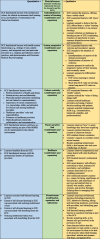Investigating the learning value of early clinical exposure among undergraduate medical students in Dubai: a convergent mixed methods study
- PMID: 40307797
- PMCID: PMC12044941
- DOI: 10.1186/s12909-025-07212-9
Investigating the learning value of early clinical exposure among undergraduate medical students in Dubai: a convergent mixed methods study
Abstract
Introduction: The benefits of Early Clinical Exposure (ECE) in medical education are often stated but there is limited evidence on how to effectively maximize its learning value. The challenge for medical educators lies in finding ways to enhance the quality of ECE in alignment with students' feedback, while realizing the learning outcomes. The purpose of this study is to investigate undergraduate medical students' perception of an innovative ECE intervention in Dubai, United Arab Emirates, developed using design-based research in alignment with adult, experiential learning theories.
Methods: A convergent mixed methods study design was utilized. The data was collected using a tailormade survey to solicit both quantitative and qualitative feedback. Quantitative data was analyzed using SPSS. Qualitative data analysis was inductive based on constructivist epistemology. Following the conclusion of the independent data analyses of the quantitative and qualitative datasets, the primary inferences were integrated using the iterative joint display analysis process.
Results: Out of the 68 students who attended the ECE, 54 responded. The percentage of the total extent of agreement that the ECE: familiarized them with learning in the clinical environment and brought forth the institutional values were 79.60% and 86.43%, respectively. The extent of active engagement and self-directed learning, with a mean of 6.80(2.42), was significantly associated with how much the learners reaped from the learning experience (P < 0.05). A novel conceptual model, namely: 'Early Clinical Exposure Added Value', with five interconnected themes, was developed from the qualitative analysis. Integration of findings led to six meta-inferences: Embeddedness in context of learning, System perspective, Patient-centricity, Theory-practice link, Resilience, and Proactiveness.
Conclusion: The more medical students engage in their learning, the more ECE contributes to building their academic resilience, and propels them in terms of clinical correlations, skills' development, and values reinforcement. Securing engagement opportunities for the learners, when designing and planning for the ECE, is essential. Optimizing the ECE learning value can happen systematically through continuously developing the respective intervention in alignment with the principles of design-based research and anchoring it in constructivism experiential learning theories.
Keywords: Adult learning theory; Align; Alignment; Based research; Basic medical sciences; Care; Clinical correlation; Clinical medical sciences; Design; Discovery; Dubai; Dubai Health; Early clinical exposure; Foundation of clinical medicine; Giving; Health professions education; Kolb’s experiential learning theory; Learning; Medical education; Ministry of Higher Education and Scientific Research; Mixed methods research; Outcome-based Evaluation Framework; Patient centricity; Patient first; Resilience; Resilient health professionals; SDG 17; SDG 3; SDG 4; SDG 9; Self-directed learning; Self-regulation; Social constructionism; Sustainable Development; Sustainable Development Goals; System perspective; Undergraduate medical education; United Arab Emirates; United Nations.
© 2025. The Author(s).
Conflict of interest statement
Declarations. Ethics approval and consent to participate: The current study adhered to the Declaration of Helsinki. It was approved by two relevant research governing entities: Institutional Review Board of MBRU (MBRU IRB- 2024–20) and Dubai Scientific Research and Ethics Committee (DSREC) at the DHA (DSREC-GL14 - 2024). The research participants gave their informed consent electronically prior to filling in the survey. Consent for publication: Not applicable. Competing interests: The authors declare no competing interests.
Figures






Similar articles
-
Effects of building resilience skills among undergraduate medical students in a multi-cultural, multi-ethnic setting in the United Arab Emirates: A convergent mixed methods study.PLoS One. 2025 Feb 27;20(2):e0308774. doi: 10.1371/journal.pone.0308774. eCollection 2025. PLoS One. 2025. PMID: 40014577 Free PMC article.
-
High-fidelity simulation versus case-based tutorial sessions for teaching pharmacology: Convergent mixed methods research investigating undergraduate medical students' performance and perception.PLoS One. 2024 Aug 16;19(8):e0302609. doi: 10.1371/journal.pone.0302609. eCollection 2024. PLoS One. 2024. PMID: 39150900 Free PMC article.
-
Professionalism-training in undergraduate medical education in a multi-cultural, multi-ethnic setting in the Gulf Region: an exploration of reflective essays.BMC Med Educ. 2024 Feb 6;24(1):117. doi: 10.1186/s12909-024-05103-z. BMC Med Educ. 2024. PMID: 38321450 Free PMC article.
-
Impact of summer programmes on the outcomes of disadvantaged or 'at risk' young people: A systematic review.Campbell Syst Rev. 2024 Jun 13;20(2):e1406. doi: 10.1002/cl2.1406. eCollection 2024 Jun. Campbell Syst Rev. 2024. PMID: 38873396 Free PMC article. Review.
-
Learning by making - student-made models and creative projects for medical education: systematic review with qualitative synthesis.BMC Med Educ. 2025 Jan 29;25(1):143. doi: 10.1186/s12909-025-06716-8. BMC Med Educ. 2025. PMID: 39881268 Free PMC article.
Cited by
-
School nutrition programs in Dubai: a landscape analysis.Front Public Health. 2025 Jul 25;13:1584497. doi: 10.3389/fpubh.2025.1584497. eCollection 2025. Front Public Health. 2025. PMID: 40786164 Free PMC article.
References
-
- J.R. F: The CanMEDS 2005 Physician Competency Framework. Better standards. Better physicians. Better care. In. Edited by Canada OoETRCoPaSo. Ottawa: The Royal College of Physicians and Surgeons of Canada.; 2005.
-
- Senok AJBA, Al Heialy S, Naidoo N, Otaki F, Davis D. Leveraging the Added Value of Experiential Co-Curricular Programs to Humanize Medical Education. Journal of Experiential Education. 2022;45:172–90.
MeSH terms
LinkOut - more resources
Full Text Sources

